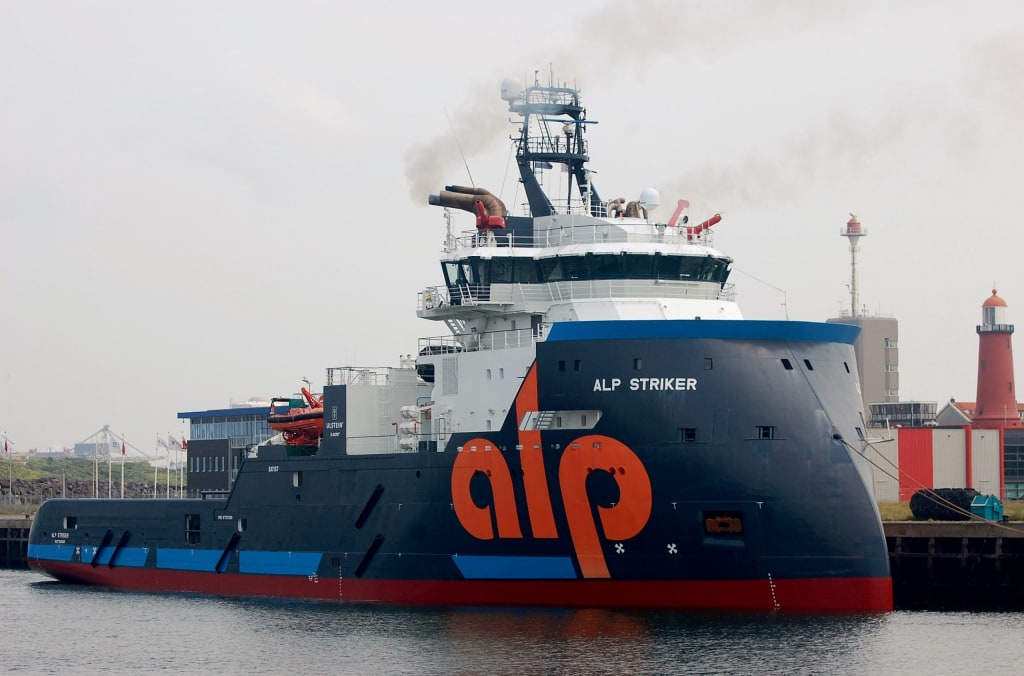The World's Strongest Ship
Moving of a $400M Drilling Rig Across the World

The process of securing and maintaining connections for towing the rig involves innovative systems. The team meticulously executes the rig's mounting plan under high tension, ensuring every detail is accounted for. As an additional safety measure, emergency wires are prepared and attached to the anchor chains, providing an extra layer of security for the rig. With extreme caution, the crew lifts and secures the heavy anchor chains using a crane, ensuring a strong and reliable connection. Massive chafing chains are also connected, further enhancing the rig's stability and readiness for the mega transport. Overall, the transportation of the West Bolsta drilling rig is a complex undertaking that demands careful planning, innovative methods, and a highly skilled team. The safety and successful delivery of such a valuable and massive rig require meticulous attention to detail at every step of the process. The chafing chain by itself weighs a staggering 4 tons and necessitates meticulous placement. Lubricating grease is employed to prevent steel fractures caused by friction. The crew diligently secures the connections for these colossal transport journeys. Center pins are utilized to prevent screws from loosening under heavy loads.
The tension in the wire construction plays a pivotal role in ensuring the success of the job. An unforeseen wire issue during an emergency has disrupted the connection. The emergency wire has become entangled on the pontoon, impeding the connection process. The engine control room is staffed around the clock to monitor the tug's engines. Numerous challenges arise during these mega transports. The electrician plays a crucial role in conducting rounds and inspections on the vessel. The crew requires shared events and moments of enjoyment to alleviate the monotony of the long journey. Delays in anchorage at Walvis Bay result in exorbitant costs of thousands of dollars per hour. During refueling, the tug and rig must be disconnected for safety purposes. West Bolsta employs a Dynamic Positioning System to maintain an accurate position near the rig. The successful completion of emergency interventions is of utmost importance. To maintain their position in 10 KN winds, four out of the eight thrusters were utilized. The crew of Alp Striker efficiently completed the detachment and reattachment tasks in a remarkably short amount of time. The maiden voyage of O Hong Kong holds immense significance for the future of the transport business. The ship must reach its destination safely and on schedule to solidify its success. The construction of such Mega Transporters presents immense challenges for engineers and shipbuilders.
The O Hong Kong, a groundbreaking vessel, requires the captain to ensure a secure journey. The ship measures around 400m in length, surpassing the Titanic and even the Empire State Building in size. It can carry 21,433 containers, with a total weight of approximately 191,000 deadweight tons. Rotterdam stands as Europe's largest port, while Shanghai's deep-water Port serves as the initial destination for this mega transporter. Shanghai's Deepwater Port holds the title of the busiest and largest port globally, managing 13 million containers annually. The birthing process for the O Hong Kong involves a risky and tense maneuver, with the pilot boat approaching the vessel for boarding. Captain Lam Chung Fat expertly navigates through tight birthing maneuvers amidst other container ships, considering factors like water depth, sandbanks, and port hazards. With the assistance of three tugboats, the mega transporter is carefully guided to prevent any collisions. The mega transport embarks on a 30-day journey to Europe, transporting a variety of goods including sneakers, laptops, televisions, and hazardous chemicals. Chief Officer Lim Kang shares the emotions and challenges faced onboard the O Hong Kong. Securing containers is of utmost importance for safe transport, with struts fastening containers to lashing bridges and to each other.
The crew diligently checks the security measures daily, especially in anticipation of potential storms or high waves. Pirates are using grappling hooks to threaten the crew. To maintain good visibility and night vision, the crew must keep the lights low. The ship encounters unmarked boats and must signal warnings to avoid danger. Loading mega transporters at smart ports requires efficiency and safety measures. Smart ports, such as those in Singapore, utilize remote-controlled cranes for faster loading and precise operations. Emergency drills and procedures ensure the crew is prepared to handle fire incidents on Hazmat containers on the ship. The Suez Canal is crucial for shipping competitiveness. A new canal section opened in 2015 to tackle challenges. Pilots navigate ships through challenging passages, with high fees based on weight. Pilots in the Suez Canal undergo rigorous training for 15 years and use simulators to train for various ship sizes and weather conditions. Chief pilot Faruk Fuda relies on over 40 years of experience to guide mega freighters through the canal. Hundreds of spectators witness the maiden voyage of a Mega transport ship in Rotterdam. Captain Lam Chung Fat will continue to command O Hong Kong for 6 more months after a successful journey. The trapper ship docked at Antwerp stands as the largest automobile transporter globally, transforming the landscape of vehicle logistics on a worldwide scale. It embarks on a 28,000 km voyage spanning continents, completing the journey in just 50 days. The Port Captain faces a daunting challenge, striving to board 1,000 cars within a mere 16-hour window.
The meticulous process involves clearing, registering, and loading each car onto the vessel, ensuring their secure placement during the parking phase. Special straps are meticulously fastened to lashing hooks and car rims to prevent any swaying during the oceanic voyage. Quick adjustments and on-the-spot improvisations are crucial to maintaining an even distribution of cargo weight. The mega transporter readies itself for its global expedition, with all 1,000 cars perfectly positioned an hour ahead of schedule. Preparations are underway for the loading of heavy cargo and trucks at upcoming ports, with a focus on the efficient handling of the substantial loads. Chief Officer Van Chung supervises the technical modifications in the cargo area to accommodate the large trucks, manually raising deck panels to double the cargo height without the need for intricate technology, thereby facilitating the transport of various cargo types with utmost efficiency. Pressure is increasing as the clock ticks down for loading the massive equipment. Struggling to accommodate the heavy units on the lower deck, the possibility of moving them to the upper deck is being considered. Plan B includes the use of rubber mats to prevent damage to the ramp during the removal of the machinery. Mega transport faces risks at the Panama Canal. Captain Su Chung is concerned about severe storms and the potential harm to the cargo.
First Officer Hong is tasked with securing the valuable cargo and preventing any damage. It is essential to maintain the proper lashing tension to secure the cargo. The crew must ensure that the cargo is lashed and secured with utmost precision to prevent any damage. Additional security measures, such as adding chocks, are implemented to prevent the vehicles from shifting during the impending storm. The Panama Canal utilizes three lock chambers to raise ships 27m above sea level. The ship is lifted by 9m in each of the three lock chambers, requiring precise positioning by the captain and pilot. While the Trapper employs an automatic steering system on the open sea, manual maneuvering is necessary through the locks. Pilots and tugboats ensure a safe passage through the lock chambers. The chamber is filled with water from Gatun Lake, raising the Trapper to 18m. Nearly 300 pilots and 36 tugboats are involved in guiding ships through the locks, with each passage costing up to €400,000. The trapper is making its way through the Panama Canal towards New Zealand, navigating the lower chamber locks as it approaches the Pacific Ocean level. Upon arrival in New Zealand, a final inspection will be conducted to ensure compliance with strict quarantine regulations. The successful journey of Mega Transports Final Chapter culminated in the timely arrival of the world's largest auto liner in Auckland, New Zealand, carrying thousands of new cars and hundreds of high and heavy vehicles for their new owners.
This achievement was made possible by the dedication of dock workers, port captains, and meticulous logistics planning. Precise loading techniques were employed to maintain stability and ensure dryness, especially during cargo deck flooding to maintain the ship's balance. The loading process for luxury yachts is a delicate operation that requires special attention to prevent damage. The transportation cost for luxury yachts typically amounts to around $250,000 per voyage, with additional expenses for maintenance and crew. Careful handling and support are essential during the drainage process to safeguard the yachts. Divers are directed to use heavy metal supports to stabilize the yachts when the water level decreases. The team leader is responsible for ensuring the overall safety and well-being of the operation. Bowie faces challenges due to poor visibility and losing a flipper, yet he remains composed and confident. Bowie and his team navigate through the obstacles of the current, ship swells, and underwater hazards to inspect the vessel.
The divers inspect and repair boat leaks underwater. The water level in the cargo deck has decreased by 1 meter as a result of the divers' efforts. The captain is preparing for potential changes in water level of up to half a meter. Container ships could pose a threat to the yacht Express. The yacht Express is still sitting too low in the water, with the cargo deck water level being too high. The team must remove enough water from the cargo deck before the container ship passes to avoid chaos and potential sinking. The team completed the task with exceptional performance. They are fatigued but proud of their accomplishments. The next objective is to install additional aluminum supports to ensure stability during the Atlantic Crossing. The divers have secured and stabilized the valuable yachts. Yachts are prepared for transit, with no issues reported by the transporters. The journey of Yacht Express spans 4,600 nautical miles from Florida to Genoa, Italy. Propellers are utilized to minimize friction, enhancing the speed of the boat. Yacht Express was constructed with an innovative floating deck system within 1.5 years at a shipyard in China.
The crew of the mega transporter is predominantly composed of individuals from the Philippines, Russia, and Ukraine, who partake in three daily meals and make use of various amenities onboard such as a fitness room, cabins, conference rooms, movie theater, and swimming pool. Yacht Express takes necessary precautions to navigate rough seas and secure the cargo. The vessel steers clear of waves exceeding 4 meters in height and closely monitors weather conditions throughout the voyage. Ballast tanks are employed to maintain watertightness, ensuring the cargo deck remains safely flooded, with emergency passageways available for unforeseen circumstances. Luxury Yachts are ferried across the open sea by the Mega Transporter. Yacht Express facilitates the provision of luxury Yachts to affluent individuals worldwide. Captain Andre and the crew effectively transport Yachts to exotic destinations across the Seven Seas.
About the Creator
Isaac Ekow Anyidoho
A calm person with a cascading mind filled with ideas of my own and know that; I can make a difference with the support of people like you. Thank you.
Enjoyed the story? Support the Creator.
Subscribe for free to receive all their stories in your feed. You could also pledge your support or give them a one-off tip, letting them know you appreciate their work.





Comments
There are no comments for this story
Be the first to respond and start the conversation.